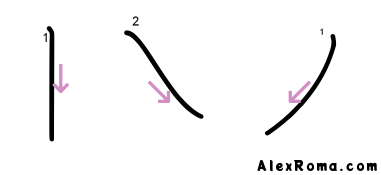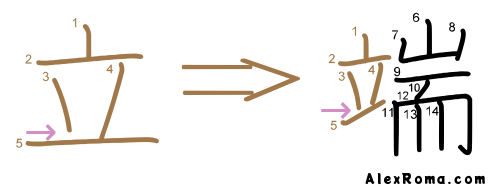Stroke direction rule 2 – top to bottom
The rule states:
Vertical and diagonal strokes are written from the top to the bottom.
The diagram below shows a vertical stroke and two diagonal/slanted strokes written top-to-bottom.

Below you can see the characters 川 kawa, 十 too, 本 moto, 八 yattsu. The image is self-explanatory.

All the vertical and diagonal strokes are written top to bottom, as indicated by the small numbers placed near the strokes’ higher end.
Apparent exceptions
Sometimes you will encounter shapes that have diagonal/slanted strokes that are written left-to-right, apparently violating rule 2. In reality these strokes are not exceptions: they follow stroke direction rule 1, the left-to-right rule, because they are considered horizontal strokes.

In the diagram above, the 5th stroke of the kanji 端 hashi is remarkably slanted, but it is written from the left to the right. The reason is that the left component of 端 hashi is a known independent shape: 立 tatsu.
Within the kanji 立 tatsu (I am using terms such as “kanji” and “shape” interchangeably), the bottom stroke (or the 5th stroke) is a long horizontal stroke. For this reason it obviously follows the left-to-right rule.
When the shape is found on the left side of a character such as 端 hashi, the lower stroke is made to look visibly slanted for stylistic reasons, but it inherits the stroke direction of the original character 立 tatsu.
The visual difference is only a superficial difference. The substance is that the stroke remains a horizontal stroke, and it doesn’t matter if the style differs. In the diagram below you can see more examples of this stylistic phenomenon.

When a kanji is made up of two components, the lowermost horizontal stroke of the left-hand shape may (or may not) become markedly slanted in order to preserve the balance in the overall shape of the character. Pay attention to the characters 足 ashi and 路 ji: the two lower strokes in 足 ashi are completely transformed in 路 ji.
Within a couple of months of studying kanji you will learn to recognise these horizontal strokes in disguise.

I have identified two less obvious cases where a slanted stroke must be written left-to-right. They are the 3rd stroke in 北 kita ‘North’, and the 5th stroke in 虫 mushi ‘insect’. It would be a good thing if you could memorise these two characters now.
